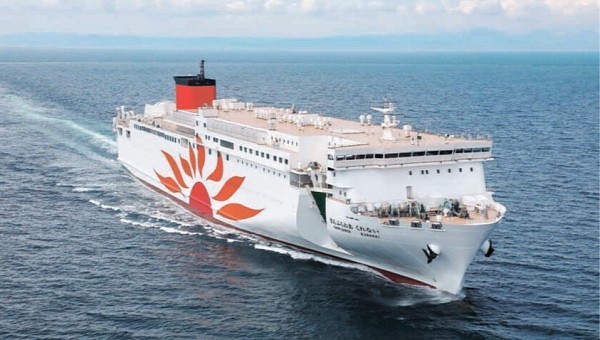In parts of the world where ferries are typical means of transportation for both passengers and freight, it’s easy to see why greater efforts were made to make them greener. Scandinavian countries are at the forefront, with multiple projects for the development of ferries with hybrid propulsion or dual-fuel systems. In Japan, the Sunflower Kurenai is the first one of its kind to kick off operations.
It takes time to develop and implement alternative solutions for maritime transportation, especially when it involves building an entirely different type of vessel, from scratch. Mitsui O.S.K. Lines (MOL) had the ambitious plan of introducing the first dual-fuel ferries in Japan, and it can proudly confirm that the first one is already in operation.
It’s the Sunflower Kurenai, first presented to the world at the beginning of last year. That’s when its naming ceremony took place, at the Mitsubishi Heavy Industries’ plant in the Yamaguchi Prefecture. As is most often the case, this new ship was meant to replace the conventional ferries that were circulation on specific routes, at the time.
The Sunflower Kurenai replaced the Sunflower Ivory, carrying people and goods on the Osaka-Beppu route. This is an important route that connects the Sunflower Ferry Terminal in the Osaka Prefecture (Ferry Sunflower is a MOL company) and the Beppu International Tourist Port in the Oita Prefecture.
Passengers on this route will be pleased to discover the perks of this new ferry. First of all, it’s considerably larger than its predecessor (652 feet/199 meters, compared to 502 feet/153 meters). This enabled the addition of a Grand Bathroom with a double floor area compared to the previous one, a larger number of seats in the restaurant, and a more generous public area on board (including a brand-new three-layer Atrium).
The new ferry is also more spacious, boasting a 17,300-ton volume versus 9,245 tons. This translated to an increased cargo capacity, including trucks. According to MOL, the ferry also provides increased room and comfort for the truck drivers on board.
But what makes the Sunflower Kurenai a pioneer in its country is the use of LNG (liquefied natural gas). The vessel was fitted with a dual-fuel engine that can run both on standard maritime fuel and LNG.
Although this doesn’t make the ferry 100% green, it has a significant positive impact on emission reduction. According to the builder, it’s expected to operate with 25% fewer CO2 emissions, and completely eliminate sulfur oxide (SOx) emissions.
Sunflower Kurenai’s recent LNG fueling was also a first for Japan, due to the specific procedure.
The new LNG-fueled ferry will soon be joined by its sister ship, Sunflower Murasaki, and two more LNG-fueled vessels will also be built. All in all, MOL’s Ferry Sunflower is expected to operate four eco-friendly ferries running on LNG, by 2025.
It’s the Sunflower Kurenai, first presented to the world at the beginning of last year. That’s when its naming ceremony took place, at the Mitsubishi Heavy Industries’ plant in the Yamaguchi Prefecture. As is most often the case, this new ship was meant to replace the conventional ferries that were circulation on specific routes, at the time.
The Sunflower Kurenai replaced the Sunflower Ivory, carrying people and goods on the Osaka-Beppu route. This is an important route that connects the Sunflower Ferry Terminal in the Osaka Prefecture (Ferry Sunflower is a MOL company) and the Beppu International Tourist Port in the Oita Prefecture.
Passengers on this route will be pleased to discover the perks of this new ferry. First of all, it’s considerably larger than its predecessor (652 feet/199 meters, compared to 502 feet/153 meters). This enabled the addition of a Grand Bathroom with a double floor area compared to the previous one, a larger number of seats in the restaurant, and a more generous public area on board (including a brand-new three-layer Atrium).
The new ferry is also more spacious, boasting a 17,300-ton volume versus 9,245 tons. This translated to an increased cargo capacity, including trucks. According to MOL, the ferry also provides increased room and comfort for the truck drivers on board.
But what makes the Sunflower Kurenai a pioneer in its country is the use of LNG (liquefied natural gas). The vessel was fitted with a dual-fuel engine that can run both on standard maritime fuel and LNG.
Although this doesn’t make the ferry 100% green, it has a significant positive impact on emission reduction. According to the builder, it’s expected to operate with 25% fewer CO2 emissions, and completely eliminate sulfur oxide (SOx) emissions.
Sunflower Kurenai’s recent LNG fueling was also a first for Japan, due to the specific procedure.
The new LNG-fueled ferry will soon be joined by its sister ship, Sunflower Murasaki, and two more LNG-fueled vessels will also be built. All in all, MOL’s Ferry Sunflower is expected to operate four eco-friendly ferries running on LNG, by 2025.







